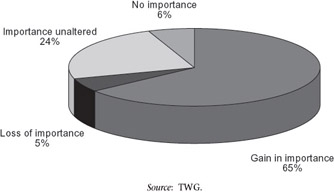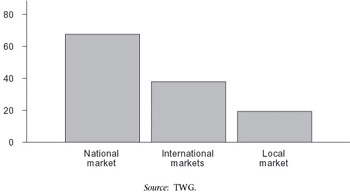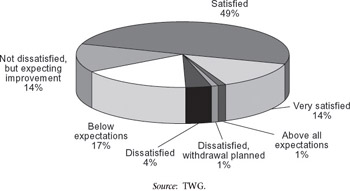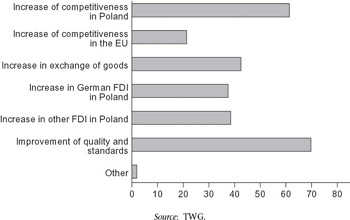3.2 The experiences of German enterprises in Poland: a survey
3.2 The experiences of German enterprises in Poland: a survey [1]
3.2.1 German enterprises in Poland
Official statistics show that 45 765 enterprises with foreign equity interest were registered in Poland at the end of 2001 (Figure 3.5). However according to the TWG (a German “Polish organization for business promotion), this figure included a number of ˜letter box or one-man firms that were not actively engaged in business but had been established in anticipation of future business opportunities. Furthermore the longstanding expectation that there would be an increase in the minimum deposit for limited liability companies “ which in fact was implemented in January 2001 “ may have pushed up the number of enterprise registrations. A figure of about 30 “35 000 active enterprises is probably more realistic.

Figure 3.5: Enterprises with foreign capital investment, 1989 “2001 (absolute numbers ). Source: GUS, Warsaw.
Of all the enterprises with a dominant foreign ownership in Poland, German enterprises form by far the largest group , with approximately 6000 active firms, although the TWG again considers this figure to be artificially high. Between 1993 and 1998 there was a rapid increase in the number of foreign enterprises (Table 3.3), including a sizeable number of small German enterprises with minor investment budgets .
| Number of firms | Investment budget (million zloty) | |||||
|---|---|---|---|---|---|---|
| 1993 | 1998 | Change in rate (%) | 1993 | 1998 | Change in rate (%) | |
| Germany | 2943 | 5 177 | 76 | 1356 | 8 928 | 558 |
| Total foreign | 7935 | 12 649 | 59 | 4854 | 43 545 | 797 |
| Source : GUS, Warsaw. | ||||||
3.2.2 German investors in Poland: the trend towards autonomy
German enterprises prefer forms of ownership that guarantee them autonomy over their operations in Poland. Over half of such firms are entirely funded with German capital and almost 75 per cent hold a majority, controlling share. Official statistical data and the TWG s consultancy experience and surveys indicate an increased trend towards a high degree of decision-making autonomy and a controlling share among German investors. The main reasons for this development are as follows :
-
Poland s continuing political and economic stability has created confidence among German investors about their medium- to long- term prospects.
-
Increasing market know-how has enabled German firms to rely on their own skills and resources.
-
The majority of German enterprises have moved away from the cautious strategy they adopted during the early exploratory stages and are actively engaging in market development.
During the last two years this tendency has markedly increased, and even small and medium- sized enterprises prefer to take an autonomous approach to the Polish market. Unlike investors from the United States, France and other countries , the German engagement in Poland is strongly characterized by medium-sized enterprises.
3.2.3 Attractive regions for foreign investment
According to Polish statistics, foreign enterprises invest mainly in the traditional industrial areas of Warsaw, Silesia, Greater Poland and Lower Silesia, especially the Wroclaw area (Figure 3.6). While the regional distribution of German firms generally follows this trend there is a concentration of medium-sized enterprises in West Poland. Geographical proximity to the parent company in Germany facilitates cross-border activities and even the management of the enterprise by the German headquarters.

Figure 3.6: German investment in major Polish regions. Source: TWG.
3.2.4 Key reasons for locating investment in Poland
According to a TWG survey, the main reason for investing in Poland is not the low labour costs or other cost- related factors, but rather the sales potential of a market with almost 40 million people (Figure 3.7). Low labour costs come a distant second, according to the survey. This trend has steadily intensified in recent years: for 65 per cent of German enterprises Poland s market potential has become more important in recent years (Figure 3.8) and low labour costs have declined in importance. However, for almost 45 per cent of enterprises low labour costs were a strong factor in their decision to enter the Polish market.

Figure 3.7: German enterprises main reasons for investing in Poland (percentage of all responses). Source: TWG.

Figure 3.8: The importance of Poland as a sales market. Source: TWG.
The perceived potential of the Polish domestic market is also reflected in the priorities set by German enterprises in respect of their future marketing strategies in Poland. High expectations are placed on the expansion of the entire national market and “ in stages “ international expansion as well. In contrast less importance is being placed on concentrated local markets (Figure 3.9).

Figure 3.9: Expected market development in 2003 (percentage of total citations, multiple answers). Source: TWG.
3.2.5 Poland as a procurement market
With regard to Poland as a procurement market the situation is by no means uniform. Foreign car producers in Poland, for example, still purchase most of their supplies abroad or from foreign suppliers based in Poland. In contrast 90 per cent of all input supplies for the food industry are purchased on the Polish market. On the whole, however, the number of companies for which Poland is an important procurement market is growing (Figure 3.10).

Figure 3.10: The significance of Poland as a procurement market. Source: TWG.
3.2.6 Machinery and technological equipment
Almost 70 per cent of machines used by German firms in Poland were new when installed (Figure 3.11). Only about 26 per cent of equipment had already been in use outside Poland, refuting the common supposition that German enterprises have a strong tendency to move their old equipment to Poland. Furthermore 80 per cent of enterprises intend to carry out a further modernization of their plants.

Figure 3.11: Origin of machinery and equipment used by German firms in Poland. Source: TWG.
3.2.7 Workforce performance
There is a common prejudice that Polish workers are less industrious and less motivated than their German counterparts. However the assessment of Polish workers by German enterprises in Poland paints a different picture (Figure 3.12). This finding is underlined by the respondents conclusions on the positive attributes of Polish employees, with industriousness, flexibility and resilience heading the list. Entrepreneurial spirit, accountability and the ability to work in teams were evaluated less favourably, as was company loyalty, as Polish employees, especially those with high qualifications, are much more apt to change jobs than are their German counterparts. However, German managers stress that Polish employees are highly motivated and eager to learn, particularly younger workers.

Figure 3.12: Performance of Polish workforce in comparison with German coworkers. Source: TWG.
3.2.8 The competitive situation in Poland
In recent TWG surveys more than 75 per cent of German enterprises judged competitiveness in Poland to be high or extremely high (Figure 3.13), compared with only 30 per cent in 1996. Fifty-seven per cent of German firms considered Poland to be as or even more competitive than Germany. This intensification of competitiveness was an expression of the strengthened performance of domestic enterprises as well as growing competition among foreign enterprises in the Polish market.

Figure 3.13: Degree of competitiveness in Poland. Source: TWG.
3.2.9 Positive and negative location factors
In 1996 the difficulties encountered at border crossings and the cumbersome administrative processes were among the factors most heavily criticized by German enterprises. However they gave a high rating to Polish wage levels and employees motivation and qualifications. The Polish populations acceptance of and positive attitude towards the German enterprises was also noted. In view of German “Polish history and the strong awareness of this in Poland, this finding was especially pleasing.
In 2002 the border crossing problem dropped from first to fifth place on the negative scale (Figure 3.14). This could be due to the fact that efficient logistical procedures had been developed, but it could equally be the result of real administrative improvements. However general administrative problems and the controlling and monitoring activities of the Polish authorities (from tax inspection to hygiene regulations), which were perceived as highly excessive, still ranked one and two on the list of negative factors respectively. In this regard allowances must be made for the numerous new rules and regulations that had to be adopted in preparation for Poland s accession to the EU.

Figure 3.14: Perceived business obstacles in Poland, 2002. Source: TWG.
Also viewed unfavourably were the lack of individual accountability of Polish employees, the transportation infrastructure and the unavailability of loans with suitable terms and conditions.
The respondents noted general progress in the service sector in Poland, especially in the banking and transportation industries. In addition 40 per cent perceived an improvement in their relationship with the fiscal authorities, although negative assessments still dominated.
On the basis of the TWG s surveys and observations the ranking of business obstacles can be summarized as follows:
-
Legal uncertainty “ frequent changes in laws and regulations.
-
Bureaucracy and excessive state controls.
-
Barriers due to language and cultural differences.
-
Unsatisfactory structure of financing funds and insufficient promotion measures.
-
Poor transport infrastructure.
-
Problematic border situation.
-
Difficult relationship with the tax office and other authorities.
-
Poor quality and timing of deliveries.
3.2.10 Degree of general satisfaction of German enterprises in Poland
In the 1996 survey 11 per cent of German managers were clearly dissatisfied with their operations in Poland, 30 per cent claimed to be neither dissatisfied nor satisfied, over 50 per cent were satisfied and 4 per cent were very satisfied. This was a positive result considering that the enterprises were still in the early stages of development and still had to come to terms with the basic conditions of operating in a foreign country. The 1999/2000 survey produced the results shown in Figure 3.15.

Figure 3.15: Degree of satisfaction of German investors in Poland, 1999 “2000. Source: TWG.
The expectations of German enterprises regarding Poland s entry to the EU (Figure 3.16) also indicate a positive assessment of the future development of this region.

Figure 3.16: Expectations of German enterprises after Poland s accession to the EU (number of citations). Source: TWG.
The following summary outlines the key decision parameters for German investment in Poland and the main reasons for the general satisfaction of German businesses in this market:
-
Expected economic development of and market potential in Poland.
-
Labour costs.
-
Expected effects from the entry of Poland to the EU (for instance improvements in quality and standards in Poland as well as general business expansion).
-
Regional location advantages (geographical proximity to Germany and central position in Eastern Europe).
-
Suitable human resources.
-
Growing importance of Poland as a procurement market.
[1] The data in this section are drawn from a series of empirical studies by the German “Polish organization for business promotion (TWG) on German investors and their experiences in Poland.
EAN: 2147483647
Pages: 121